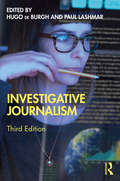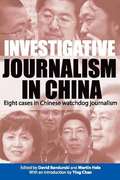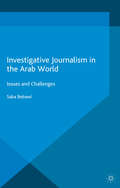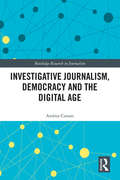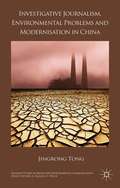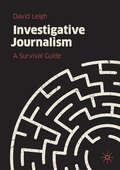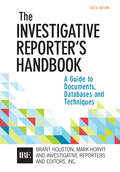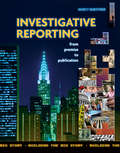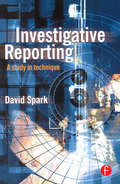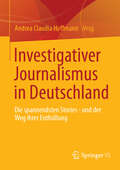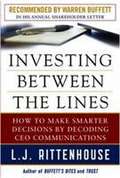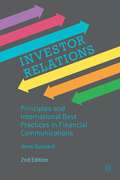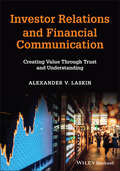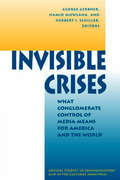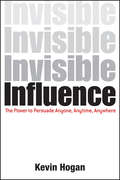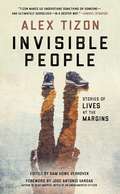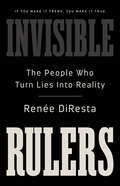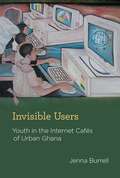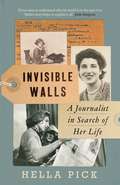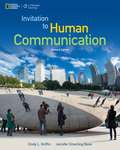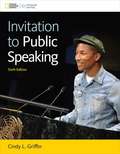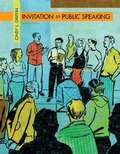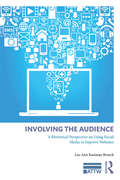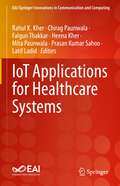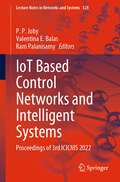- Table View
- List View
Investigative Journalism
by Hugo de Burgh; Paul LashmarThis third edition maps the new world of investigative journalism, where technology and globalisation have connected and energised journalists, whistle-blowers and the latest players, with far-reaching consequences for politics and business worldwide. In this new edition, expert contributors demonstrate how crowdsourcing, big data, globalisation of information, and changes in media ownership and funding have escalated the impact of investigative journalists. The book includes case studies of investigative journalism from around the world, including the exposure of EU corruption, the destruction of the Malaysian environment, and investigations in China, Poland and Turkey. From Ibero-America to Nigeria, India to the Arab world, investigative journalists intensify their countries’ evolution by inquisition and revelation. This new edition reveals how investigative journalism has gone digital and global. Investigative Journalism is essential for all those intending to master global politics, international relations, media and justice in the 21st century.
Investigative Journalism in China
by David BandurskiDespite persistent pressure from state censors and other tools of political control, investigative journalism has flourished in China over the last decade. This volume offers a comprehensive, first-hand look at investigative journalism in China, including insider accounts from reporters behind some of China's top stories in recent years. While many outsiders hold on to the stereotype of Chinese journalists as docile, subservient Party hacks, a number of brave Chinese reporters have exposed corruption and official misconduct with striking ingenuity and often at considerable personal sacrifice. Subjects have included officials pilfering state funds, directors of public charities pocketing private donations, businesses fleecing unsuspecting consumers - even the misdeeds of journalists themselves. These case studies address critical issues of commercialization of the media, the development of ethical journalism practices, the rising specter of "news blackmail," negotiating China's mystifying bureaucracy, the dangers of libel suits, and how political pressures impact different stories. During fellowships at the Journalism & Media Studies Centre of the University of Hong Kong, these narratives and other background materials were fact-checked and edited by JMSC staff to address critical issues related to the media transitions currently under way in the PRC. This engaging narrative gives readers a vivid sense of how journalism is practiced in China. --David Bandurski is a scholar at the University of Hong Kong's China Media Project, a research and fellowship initiative of the Journalism & Media Studies Centre. Martin Hala has taught journalism at the Universities in Prague and Bratislava. -
Investigative Journalism in the Arab World: Issues and Challenges (Palgrave Studies in Communication for Social Change)
by Saba BebawiThis is the first book that looks into the state and role of investigate journalism in the Arab world. It explores the vital role the media could potentially play in informing and empowering society, to assist in opening up the communicative space in a region where this has previously been taboo.
Investigative Journalism, Democracy and the Digital Age (Routledge Research in Journalism)
by Andrea CarsonTheoretically grounded and using quantitative data spanning more than 50 years together with qualitative research, this book examines investigative journalism’s role in liberal democracies in the past and in the digital age. In its ideal form, investigative reporting provides a check on power in society and therefore can strengthen democratic accountability. The capacity is important to address now because the political and economic environment for journalism has changed substantially in recent decades. In particular, the commercialization of the Internet has disrupted the business model of traditional media outlets and the ways news content is gathered and disseminated. Despite these disruptions, this book’s central aim is to demonstrate using empirical research that investigative journalism is not in fact in decline in developed economies, as is often feared.
Investigative Journalism, Environmental Problems and Modernisation in China
by Jingrong TongThis book examines how the news media in general, and investigative journalism in particular, interprets environmental problems and how those interpretations contribute to the shaping of a discourse of risk that can compete against the omnipresent and hegemonic discourse of modernisation in Chinese society.
Investigative Journalism: A Survival Guide
by David LeighAt a time of hyper-partisanship, media fragmentation and "fake news", the work of investigative journalism has never been more important. This book explores the history and art of investigative journalism, and explains how to deal with legal bullies, crooked politicians, media bosses, big business and intelligence agencies; how to withstand conspiracy theories; and how to work collaboratively across borders in the new age of data journalism. It also provides a fascinating first-hand account of the work that went into breaking major news stories including WikiLeaks and the Edward Snowden affair.Drawing on over 40 years of experience with world-leading investigative teams at newspapers including the Guardian and The Washington Post, award-winning journalist David Leigh provides an illuminating insight into some of the biggest news events of the 20th and 21st centuries. This book is essential reading for anyone interested in the behind-the-scenes work of journalists and news organizations. It also acts as an essential practical toolkit for both aspiring and established investigative journalists.
Investigative Reporters Handbook: A Guide To Documents, Databases, And Techniques
by Brant Houston Mark Horvit Investigative Reporters & Eds.Published with Investigative Reporters and Editors, Inc. (IRE), The Investigative Reporter’s Handbook is the best-selling classroom and newsroom classic. Useful as a textbook in advanced journalism courses and as a reference for professional journalists, this book shows students how to use fundamental news reporting and writing skills like gathering sources, tracking information, and interviewing to pursue investigative stories in a variety of beats — from the government and education to healthcare, the environment and real estate. In addition to discussing the latest techniques and challenges in the profession, the fifth edition is now thoroughly streamlined, making it easier to locate the resources that investigative reporters need to get the story.
Investigative Reporting from Premise to Publication
by Marcy BurstinerThis book gives readers the confidence they need to handle any investigative reporting assignment and to produce demonstrated results. Its step-by-step progression covering the entire investigative process will help them stay on track to complete stories of any size. The book answers relevant questions such as "Where can I find a story?" "What do I do when a source won't talk?" "How can I find the right documents to support my story?" "How can I present this story online?" and "How can a spreadsheet keep it all from falling apart?" Investigative Reporting contains full stories and timely examples from both professional and student reporters. Each chapter concludes with sequential "Big Story" assignments to help readers research, write and publish their own investigative stories. Web links to online resources (including public records information, computer-assisted reporting techniques and interactive investigative story examples) will help readers move smoothly and successfully through an investigative story or team reporting project, whether for print, broadcast or the Web.
Investigative Reporting: A study in technique
by David SparkThis important book defines what investigative reporting is and what qualities it requires. Drawing on the experience of many well-known journalists in the field, the author identifies the skills, common factors and special circumstances involved in a wide variety of investigations. It examines how opportunities for investigations can be found and pursued, how informants can be persuaded to yield needed information and how and where this information can be checked. It also stresses the dangers and legal constraints that have to be contended with and shows real life examples such as the Cook Report formula, the Jonathan Aitken investigation and the Birmingham Six story. David Spark, himself a freelance writer of wide experience, examines how opportunities for investigations can be found and pursued, how informants can be persuaded to yield needed information and how and where this information can be checked. He also stresses the dangers and legal constraints that have to be contended with and shows investigators at work in two classic inquiries: · The mysterious weekend spent in Paris by Jonathan Aitken, then Minister of Defence Procurement· The career of masterspy Kim PhilbyInvestigative Reporting looks at such fields for inquiry as company frauds (including those of Robert Maxwell), consumer complaints, crime, police malpractice, the intelligence services, local government and corruption in Parliament and in overseas and international bodies.The author believes that the conclusions that emerge from this far-reaching survey are of value not only in investigative journalism, but to practitioners in all branches of reporting.
Investigativer Journalismus in Deutschland: Die spannendsten Stories - und der Weg ihrer Enthüllung
by Andrea Claudia HoffmannDieser Band bietet einen Überblick über die herausragendsten investigativen Recherchen im deutschsprachigen Raum und analysiert ihre Entstehung. Dabei geht es um wichtige politische und wirtschaftliche Themen wie den Cum-ex-Skandal, Wirecard, die Akte Schlesinger, den Terroranschlag auf den Berliner Weihnachtsmarkt, rechtsradikale Netze, die Tesla-Files, die Panama-Papers, die Sprengung der Nordsee-Pipeline und vieles mehr. Die Journalisten und Journalistinnen, die hinter diesen spannenden Recherchen stehen, berichten selbst, was sie herausgefunden haben und erklären systematisch, wie sie vorgegangen sind. Nicht zuletzt verraten sie auch, was sie aus ihrer spezifischen Recherche gelernt haben - und geben Berufsanfängern nützliche Tipps. Die Zielgruppe sind Studierende des Fachgebiets Journalismus, Medienwissenschaftler und journalistische Praktiker, die sich für die Recherchen ihrer Berufskollegen interessieren.
Investing Between the Lines: How to Make Smarter Decisions by Decoding CEO Communications
by L. J. RittenhouseIn Investing Between the Lines, CEO communications expert, L. J. Rittenhouse offers a proven methodology for accurately analyzing the worthiness of an investment: Reading corporate "fog," i.e., shareholder letters, and other corporate correspondence. Based on a model that's made believers of Warren Buffet and Jack Welch, Rittenhouse looks at the "fog" of 100 Fortune 500 companies—and then overlays these "Fog rankings" on the stock's price performance. It's a system that made Rittenhouse one of the very first to predict the Lehman Bros. implosion, and other financia disasters—and that will arm investors with the skills and knowledge to unearth hidden risks in their portfolios and pick potential winners. L. J. Rittenhouse is president of Rittenhouse Rankings Inc, a CEO strategic and investor relations company that annually conducts a benchmark survey of CEO candor and stock price performance
Investor Relations
by Anne GuimardThis practical guide on the theory and practice of Investor Relations combines the art and science of marketing, financial analysis, and financial communications in a single source. It offers expert advice and helpful tips to be used in real business life by corporate executives, financial analysts, students, and anyone competing for capital.
Investor Relations and Financial Communication: Creating Value Through Trust and Understanding (Handbooks In Communication And Media Ser.)
by Alexander V. LaskinEquips students and professionals with the fundamental skills and knowledge needed to succeed in investor relations and financial communication Investor Relations and Financial Communication is a comprehensive, up-to-date introduction to the investor relations and financial communication profession. Written by a leading educator and professional consultant, this authoritative textbook provides the well-rounded foundation necessary for anyone wanting to begin a career as an Investor Relations Officer (IRO). Detailed yet accessible chapters describe all essential aspects of the field, including communication skills, basic financial knowledge, legal and regulatory guidelines, professional standards and practices, and more. Organized in five sections, the book first identifies and defines the jobs available in investor relations and financial communication, detailing the responsibilities, titles, salaries, and key players in the industry. After thoroughly explaining the disclosure of financial and non-financial information, the author describes the regulatory environment in which professionals operate and offers expert insight into issues of corporate governance, environmental sustainability, social responsibility, shareholder activism, and crisis management. Subsequent sections highlight the day-to-day activities of investor relations and financial communication professionals and discuss the future of the field. This invaluable textbook also: Describes the responsibilities of the Investor Relations Officer throughout initial public offering, periodic reporting, and performance evaluation Discusses the role of investor relations professionals in disclosing financial information and educating the investment community Emphasizes the various skills that IROs must possess in order to do their jobs successfully, such as marketing and securities law compliance Includes end-of-chapter review questions, activities, and lists of key terms Investor Relations and Financial Communication: Creating Value Through Trust and Understanding is the perfect textbook for both professional development training programs and undergraduate and graduate courses in investor relations, and is required reading for all those working in investor relations, particularly early-career professionals.
Invisible Crises: What Conglomerate Control of Media Means for America and the World (Critical Studies in Communication and in the Cultural Industries)
by George GerbnerHidden from public sight and mind today are invisible crises that threaten our democracy and existence more than the crises we know about—or think we know about. These invisible crises include the promotion of practices that drug, hurt, poison, and kill thousands every day; cults of violence that desensitize, terrorize, and brutalize; the growing siege mentality of our cities; widening resource gaps and the most glaring inequalities in the industrial world; the costly neglect of vital institutions such as public education and the arts; and media-assisted make-believe image politics corrupting the electoral process.Deprived of sustained attention but bombarded by eruptions of surface consequences (often presented as unique events stripped of historical context), people ar bewildered, fearful, angry, and cynical.The contributors to this volume—exploring such unattended crises, analyzing why they are hidden, and focusing on the increasing concentration of culture-power that keeps them from view—maintain that a profound general crisis of social vision, public communication, and representative government underlies all of the invisible crises.
Invisible Influence: The Power to Persuade Anyone, Anytime, Anywhere
by Kevin Hogan"Invisible Influence is a masterpiece in understanding the science of influence and how to take it from convincing to compelling. Kevin Hogan shows you in plain English how to understand, apply, and master the science of persuasion. The book is brilliant- and you can be brilliantly persuasive. Buy the book, read the book, and implement the book."-Jeffrey Gitomer, author of The Sales Bible and The Little Book of Leadership"One eyebrow-raising, head-whacking, forehead-slapping technique after another. Anyone whose daily life depends on influencing people-in other words, everyone-should read this book. Buy copies for your friends and hide it from your enemies."-Richard Brodie, author of Virus of the Mind: The New Science of the Meme"Master persuaders know that it's not really about the words you use or the moves you make-other people get persuaded because of what you think and how you feel. Kevin Hogan explains in delightfully clear detail how to make these master-persuader secrets work for you. Not only that, he also explains why all of this works, and he shows you the exact scientific research that proves it!"-David Garfinkel, author of Advertising Headlines That Make You Rich"Invisible Influence is a masterpiece. It will be the master influencer's reference book for the years to come. Invisible influence is like oxygen, you can't see it, but your life depends on it. In this book, you will discover the persuasion tactics that will compel your clients to say yes to you-again and again."-Roberto Monaco, www.influenceology.com"Dump the script-it's old news before the ink's dry. Trust yourself and use your new understanding of the ever-changing context to succeed. In his fascinating book, Hogan weaves established research findings into a handbook for successful influence. The guidelines are obvious but hidden, simple but profound. Understand them and you've mastered the complex and crucial art of persuasion."-William D. Crano, author of The Rules of Influence: Winning When You're in the Minority"Many write on the topic of persuasion. Precious few genuinely understand it. Kevin is one of those precious few. Read everything you can by him."-Mark Joyner, founder and CEO of Simpleology, www.simpleology.com
Invisible People: Stories of Lives at the Margins
by Alex Tizon Sam Howe Verhovek“Somewhere in the tangle of the subject’s burden and the subject’s desire is your story.”—Alex Tizon Every human being has an epic story. The late Pulitzer Prize–winning writer Alex Tizon told the epic stories of marginalized people—from lonely immigrants struggling to forge a new American identity to a high school custodian who penned a New Yorker short story. Edited by Tizon’s friend and former colleague Sam Howe Verhovek, Invisible People collects the best of Tizon’s rich, empathetic accounts—including “My Family’s Slave,” the Atlantic magazine cover story about the woman who raised him and his siblings under conditions that amounted to indentured servitude. Mining his Filipino American background, Tizon tells the stories of immigrants from Cambodia and Laos. He gives a fascinating account of the Beltway sniper and insightful profiles of Surfers for Jesus and a man who tracks UFOs. His articles—many originally published in the Seattle Times and the Los Angeles Times—are brimming with enlightening details about people who existed outside the mainstream’s field of vision. In their introductions to Tizon’s pieces, New York Times executive editor Dean Baquet, Atlantic magazine editor in chief Jeffrey Goldberg, Pulitzer Prize winners Kim Murphy and Jacqui Banaszynski, and others salute Tizon’s respect for his subjects and the beauty and brilliance of his writing. Invisible People is a loving tribute to a journalist whose search for his own identity prompted him to chronicle the lives of others.
Invisible Rulers: The People Who Turn Lies into Reality
by Renee DiRestaAn &“essential and riveting&” (Jonathan Haidt) analysis of the radical shift in the dynamics of power and influence, revealing how the machinery that powered the Big Lie works to create bespoke realities revolutionizing politics, culture, and society. Renée DiResta&’s powerful, original investigation into the way power and influence have been profoundly transformed reveals how a virtual rumor mill of niche propagandists increasingly shapes public opinion. While propagandists position themselves as trustworthy Davids, their reach, influence, and economics make them classic Goliaths—invisible rulers who create bespoke realities to revolutionize politics, culture, and society. Their work is driven by a simple maxim: if you make it trend, you make it true. By revealing the machinery and dynamics of the interplay between influencers, algorithms, and online crowds, DiResta vividly illustrates the way propagandists deliberately undermine belief in the fundamental legitimacy of institutions that make society work. This alternate system for shaping public opinion, unexamined until now, is rewriting the relationship between the people and their government in profound ways. It has become a force so shockingly effective that its destructive power seems limitless. Scientific proof is powerless in front of it. Democratic validity is bulldozed by it. Leaders are humiliated by it. But they need not be. With its deep insight into the power of propagandists to drive online crowds into battle—while bearing no responsibility for the consequences—Invisible Rulers not only predicts those consequences but offers ways for leaders to rapidly adapt and fight back.
Invisible Users
by Jenna BurrellThe urban youth frequenting the Internet cafes of Accra, Ghana, who are decidedly not members of their country's elite, use the Internet largely as a way to orchestrate encounters across distance and amass foreign ties--activities once limited to the wealthy, university-educated classes. The Internet, accessed on second-hand computers (castoffs from the United States and Europe), has become for these youths a means of enacting a more cosmopolitan self. In Invisible Users, Jenna Burrell offers a richly observed account of how these Internet enthusiasts have adopted, and adapted to their own priorities, a technological system that was not designed with them in mind. Burrell describes the material space of the urban Internet cafe and the virtual space of push and pull between young Ghanaians and the foreigners they encounter online; the region's famous 419 scam strategies and the rumors of "big gains" that fuel them; the influential role of churches and theories about how the supernatural operates through the network; and development rhetoric about digital technologies and the future viability of African Internet cafes in the region. Burrell, integrating concepts from science and technology studies and African studies with empirical findings from her own field work in Ghana, captures the interpretive flexibility of technology by users in the margins but also highlights how their invisibility puts limits on their full inclusion into a global network society.
Invisible Walls: A Journalist in Search of Her Life
by Hella Pick'Memoirs of such richness are rare . . . a joy' JAMES NAUGHTIE'A remarkable personal journey, by one of the great political correspondents of our world - eloquent, enlightening, exhilarating' PHILIPPE SANDSA trailblazer for women in journalism, Hella Pick arrived in Britain in 1939 as a child refugee from Austria. Over nearly four decades she covered the volatile global scene, first in West Africa, followed by America and long periods in Europe. In her thirty-five years with the Guardian she reported on the end of Empire in West Africa, the assassination of President Kennedy, Martin Luther King's march from Selma to Montgomery, the Vietnam peace negotiation in Paris, the 1968 student revolt in France, the birth of the Solidarity movement in Poland, and the closing stages of the Cold War. A request for coffee on board a Soviet ship anchored in Malta led to a chat with Mikhail Gorbachev. A request for an interview with Willy Brandt led to a personal friendship that enabled her to come to terms with Germany's Nazi past.Her book is also a clarion call for preserving professionalism in journalism at a time when social media muddy the waters between fact and fiction, and between reporting and commentary.INVISIBLE WALLS tells the dramatic story of how a Kindertransport survivor won the trust and sometimes the friendship of world leaders, and with them a wide range of remarkable men and women. It speaks frankly of personal heartache and of a struggle over her Jewish identity. It is also the intensely touching story of how, despite a gift for friendship and international recognised achievements as a woman journalist, a continuing sense of personal insecurity has confronted her with a series of invisible walls.
Invitation To Human Communication (Second Edition)
by Cindy Griffin Jennifer Emerling BoneWorking in partnership with National Geographic, INVITATION TO HUMAN COMMUNICATION, 2e acknowledges the complexity of today's workplace, the power of communication, and the importance of equipping readers with the foundational skills for success in this ever-changing environment. A leader in teaching foundational communication theories and skills, the text helps readers recognize the importance and centrality of communication in their professional and personal lives. Each chapter includes case studies and tips from nationally recognized explorers, scientists, researchers, and activists. The text showcases the best of communication theories and practices as well as explores how communication is central to carrying out work, developing professional and personal relationships with others, and sharing ideas with the larger public.
Invitation To Public Speaking - National Geographic Edition
by Cindy GriffinGrounded in rhetorical tradition while offering a fresh perspective, INVITATION TO PUBLIC SPEAKING helps students understand the power and importance of public speaking--in their lives and in greater society. Intended for the introductory public speaking course, INVITATION TO PUBLIC SPEAKING engages students in the public dialogue, encourages civic engagement, and illustrates how they will apply speaking skills in their course work and throughout their careers. Speech-building exercises, thoughtful real-life examples, an invigorating art program, and an engaging voice help students comprehend public speaking as an activity to be engaged in with others, and prepares them to enter the public dialogue. INVITATION TO PUBLIC SPEAKING also features the most comprehensive integrated technology program available, giving students more interactive skill-building practice for public speaking.
Invitation to Public Speaking (2nd edition)
by Cindy L. GriffinFor this second edition of an introductory text, Griffin (speech communication, Colorado State University) expands the text's focus to emphasize public speaking as public dialogue. There is more material on civic engagement, service learning, and plagiarism, plus six new student speeches and updated examples. The text provides instructions for specific speech construction, delivery, and strategy steps, with material on technology as a learning tool and in speech preparation integrated throughout. Learning features include chapter summaries, review questions, and Internet activities.
Involving the Audience: A Rhetoric Perspective on Using Social Media to Improve Websites (ATTW Series in Technical and Professional Communication)
by Lee Ann Kastman BreuchInvolving the Audience: A Rhetorical Perspective on Using Social Media to Improve Websites examines the usability challenges raised by large complex websites and proposes ways the social web can expand usability research to address these new challenges. Using the website healthcare.gov as an initial illustration, Breuch explains how large complex websites are inherently challenged by open-ended, interactive tasks that often have multiple pathways to completion. These challenges are illustrated through two in-depth case studies, each addressing the launch of an interactive, complex website designed for a large public audience.
IoT Applications for Healthcare Systems (EAI/Springer Innovations in Communication and Computing)
by Latif Ladid Falgun Thakkar Rahul K. Kher Chirag Paunwala Heena Kher Mita Paunwala Prasan Kumar SahooThis book discusses communications technologies used in the field of healthcare, including IoT, soft computing, machine learning, big data, augmented reality, and wearable sensors. The book presents various applications that are helpful for research scholars and scientists who are working toward identifying and pinpointing the potential of this technology. The book also helps researchers and practitioners to understand and analyze the e-healthcare architecture through IoT and the state-of-the-art in IoT countermeasures with real-time challenges. Topics of interest include healthcare systems based on advanced development boards, mobile health parameters recording and monitoring systems, remote health / patient monitoring, hospital operations management, abnormality / disease detection by IoT devices, and efficient drug management. The book is relevant to a range of researchers, academics, and practitioners working on the intersection of IoT and healthcare.
IoT Based Control Networks and Intelligent Systems: Proceedings of 3rd ICICNIS 2022 (Lecture Notes in Networks and Systems #528)
by Valentina E. Balas Ram Palanisamy P. P. JobyThis book gathers selected papers presented at International Conference on IoT Based Control Networks and Intelligent Systems (ICICNIS 2022), organized by St. Joseph’s College of Engineering and Technology, Kottayam, Kerala, India, during July 1–2, 2022. The book covers state-of-the-art research insights on Internet of things (IoT) paradigm to access, manage, and control the objects/things/people working under various information systems and deployed under wide range of applications like smart cities, health care, industries, and smart homes.
